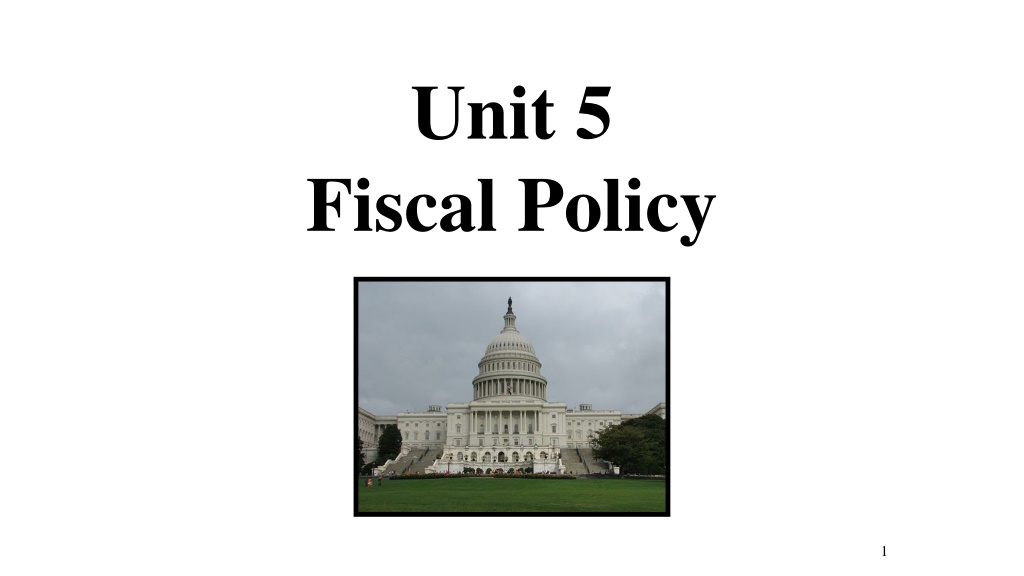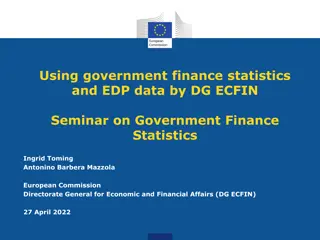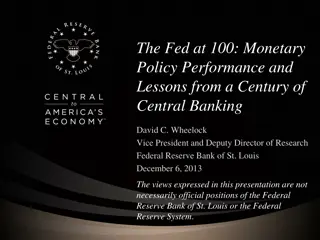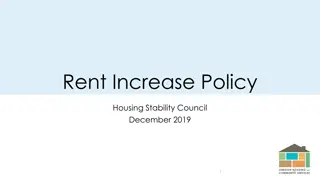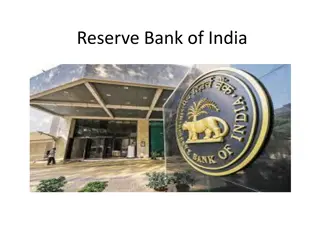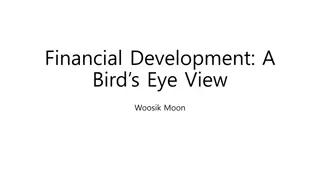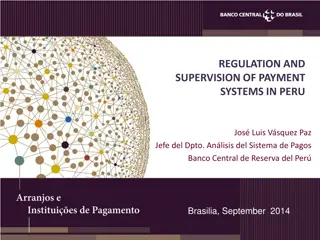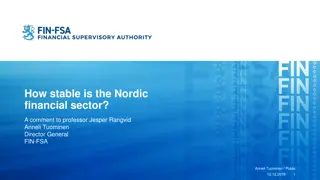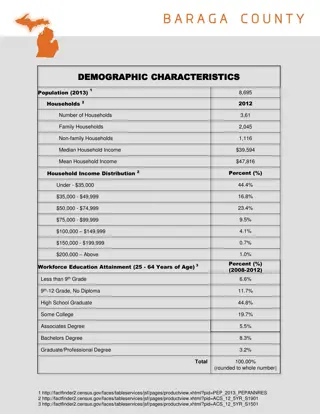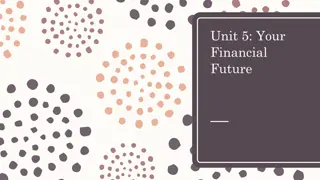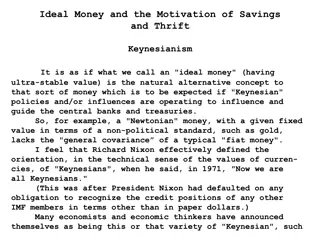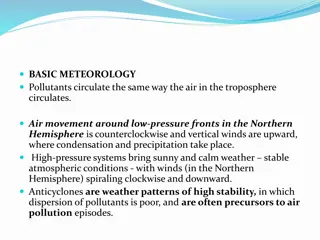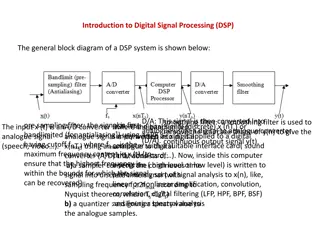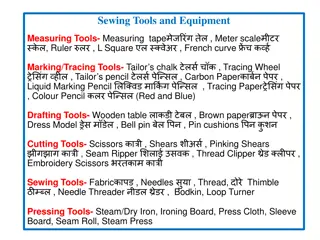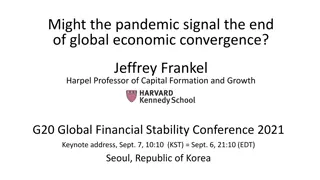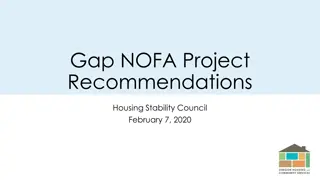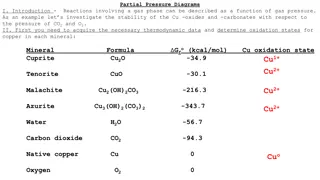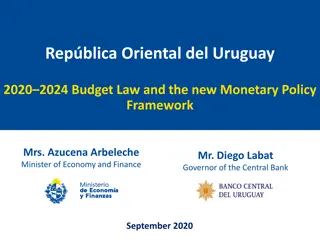Understanding Government Tools for Economic Stability
The government uses fiscal and monetary policies to stabilize the economy. Fiscal policy involves Congress's actions through government spending or taxation changes, while monetary policy is driven by the Federal Reserve Bank. Discretionary fiscal policy involves new bills designed to adjust aggregate demand, while non-discretionary policies, known as automatic stabilizers, are permanent laws aimed at counter-cyclical economic stabilization. Contractionary fiscal policy helps reduce inflation, while expansionary fiscal policy aims to lower unemployment. The government should carefully consider its spending to avoid adverse effects on aggregate demand. The multiplier effect demonstrates how initial spending changes trigger a chain reaction in the economy.
Uploaded on Oct 02, 2024 | 0 Views
Download Presentation

Please find below an Image/Link to download the presentation.
The content on the website is provided AS IS for your information and personal use only. It may not be sold, licensed, or shared on other websites without obtaining consent from the author. Download presentation by click this link. If you encounter any issues during the download, it is possible that the publisher has removed the file from their server.
E N D
Presentation Transcript
Unit 5 Fiscal Policy 1
How does the Government Stabilizes the Economy? The Government has two different tool boxes it can use: 1. Fiscal Policy- Actions by Congress to stabilize the economy. OR 2. Monetary Policy- Actions by the Federal Reserve Bank to stabilize the economy. 2
Two Types of Fiscal Policy Discretionary Fiscal Policy- Congress creates a new bill that is designed to change AD through government spending or taxation. Problem is time lags due to bureaucracy. Takes time for Congress to act. Ex: In a recession, Congress increase spending. Non-Discretionary Fiscal Policy AKA: Automatic Stabilizers Permanent spending or taxation laws enacted to work counter cyclically to stabilize the economy Ex: Welfare, Unemployment, Min. Wage, etc. When there is high unemployment, unemployment benefits to citizens increase consumer spending. 3
Contractionary Fiscal Policy (The BRAKE) Laws that reduce inflation, decrease GDP (Close a Inflationary Gap) Decrease Government Spending Tax Increases Combinations of the Two Expansionary Fiscal Policy (The GAS) Laws that reduce unemployment and increase GDP (Close a Recessionary Gap) Increase Government Spending Decrease Taxes on consumers Combinations of the Two How much should the Government Spend? 4
What type of gap and what type of policy is best? What should the government do to spending? Why? How much should the government spend? The government should increasing spending which would increase AD They should NOT spend 100 billion!!!!!!!!!! If they spend 100 billion, AD would look like this: WHY? LRAS Price level AS P1 AD2 AD1 $400 $500 Real GDP (billions) 5 FE
The Multiplier Effect The Multiplier Effect Why do cities want the Superbowl in their stadium? An initial change in spending will set off a spending chain that is magnified in the economy. Example: Bobby spends $100 on Jason s product Jason now has more income so he buys $100 of Nancy s product Nancy now has more income so she buys $100 of Tiffany s product. The result is an $300 increase in consumer spending The Multiplier Effect shows how spending is magnified in the economy. 6
What type of gap and what type of policy is best? What should the government do to spending? Why? How much should the government spend? The government should increasing spending which would increase AD They should NOT spend 100 billion!!!!!!!!!! If they spend 100 billion, AD would look like this: WHY? LRAS Price level AS P1 AD2 AD1 $400 $500 Real GDP (billions) 7 FE
The Multiplier Effect The Multiplier Effect Why do cities want the Superbowl in their stadium? An initial change in spending will set off a spending chain that is magnified in the economy. Example: Bobby spends $100 on Jason s product Jason now has more income so he buys $100 of Nancy s product Nancy now has more income so she buys $100 of Tiffany s product. The result is an $300 increase in consumer spending The Multiplier Effect shows how spending is magnified in the economy. 8
Effects of Government Spending If the government spends $5 Million, will AD increase by the same amount? No, AD will increase even more as spending becomes income for consumers. Consumers will take that money and spend, thus increasing AD. How much will AD increase? It depends on how much of the new income consumers save. If they save a lot, spending and AD will increase less. If the save a little, spending and AD will be increase a lot. 9
Marginal Propensity to Consume Marginal Propensity to Consume (MPC) How much people consume rather than save when there is an change in income. It is always expressed as a fraction (decimal). MPC= Change in Consumption Change in Income Examples: 1. If you received $100 and spent $50. 2. If you received $100 and spent $80. 3. If you received $100 and spent $100. 10
Marginal Propensity to Save Marginal Propensity to Save (MPS) How much people save rather than consume when there is an change in income. It is also always expressed as a fraction (decimal) MPS= Change in Income Examples: 1. If you received $100 and save $50. 2. If you received $100 your MPC is .7 what is your MPS? Change in Saving 11
MPS = 1 - MPC Why is this true? Because people can either save or consume 12
How is Spending Multiplied ? Assume the MPC is .5 for everyone Assume the Super Bowl comes to town and there is an increase of $100 in Ashley s restaurant. Ashley now has $100 more income. She saves $50 and spends $50 at Carl s Salon Car now has $50 more income He saves $25 and spends $25 at Dan s fruit stand Dan now has $25 more income. This continues until every penny is spent or saved Change in GDP =Multiplier x Initial Change in Spending 13
Calculating the Spending Multiplier If the MPC is .5 how much is the multiplier? 1 MPS 1 Multiplier = or Simple 1 - MPC If the multiplier is 4, how much will an initial increase of $5 in Government spending increase the GDP? How much will a decrease of $3 in spending decrease GDP? Change in GDP =Multiplier x initial change in spending 14
The Multiplier Effect Let s practice calculating the spending multiplier Multiplier = 1. If MPC is .9, what is multiplier? 2. If MPC is .8, what is multiplier? 3. If MPC is .5, and consumption increased $2M. How much will GDP increase? 4. If MPC is 0 and investment increases $2M. How much will GDP increase? Conclusion: As the Marginal Propensity to Consumer falls, the Multiplier Effect is less 1 1 or Simple 1 - MPC MPS 15
Fiscal Policy Practice Congress uses discretionary fiscal policy to the manipulate the following economy (MPC = .8) LRAS 1. What type of gap? 2. Contractionary or Expansionary needed? 3. What are two options to fix the gap? 4. How much initial government spending is needed to close gap? AD1 $100 Billion AS Price level P1 AD2 $500 $1000FE Real GDP (billions) 16
Fiscal Policy Practice Congress uses discretionary fiscal policy to the manipulate the following economy (MPC = .5) LRAS 1. What type of gap? 2. Contractionary or Expansionary needed? 3. What are two options to fix the gap? 4. How much needed to close gap? AS Price level P2 -$10 Billion AD1 AD $80FE $100 Real GDP (billions) 17
What about taxing? The multiplier effect also applies when the government cuts or increases taxes. But, changing taxes has less of an impact of changing GDP. Why? Expansionary Policy (Cutting Taxes) Assume the MPC is .75 so the multiplier is 4 If the government cuts taxes by $4 million how much will consumer spending increase? NOT 16 Million!! When they get the tax cut, consumers will save $1 million and spend $3 million. The $3 million is the amount magnified in the economy. $3 x 4 = $12 Million increase in consumer spending .18
Non Non- -Discretionary Fiscal Discretionary Fiscal Policy Policy 19
Non-Discretionary Fiscal Policy Legislation that act counter cyclically without explicit action by policy makers. AKA: Automatic Stabilizers The U.S. Progressive Income Tax System acts counter cyclically to stabilize the economy. 1. When GDP is down, the tax burden on consumers is low, promoting consumption, increasing AD. 2. When GDP is up, more tax burden on consumers, discouraging consumption, decreasing AD. The more progressive the tax system, the greater the economy s built-in stability. 20
Problems With Problems With Fiscal Policy Fiscal Policy 21
Problems With Fiscal Policy When there is a recessionary gap what two options does Congress have to fix it? What s wrong with combining both? Deficit Spending!!!! A Budget Deficit is when the government s expenditures exceeds its revenue. The National Debt is the accumulation of all the budget deficits over time. If the Government increases spending without increasing taxes they will increase the annual deficit and the national debt. Most economists agree that budget deficits are a necessary evil because forcing a balanced budget would not allow Congress to stimulate the economy. 22
Additional Problems with Fiscal Policy 1. Problems of Timing Recognition Lag- Congress must react to economic indicators before it s too late Administrative Lag- Congress takes time to pass legislation Operational Lag- Spending/planning takes time to organize and execute ( changing taxing is quicker) 2. Politically Motivated Policies Politicians may use economically inappropriate policies to get reelected. Ex: A senator promises more welfare and public works programs when there is already an inflationary gap. 23
Additional Problems with Fiscal Policy 3. Crowding-Out Effect In basketball, what is Boxing Out ? Government spending might cause unintended effects that weaken the impact of the policy. Example: We have a recessionary gap Government creates new public library. (AD increases) Now but consumer spend less on books (AD decreases) Another Example: The government increases spending but must borrow the money (AD increases) This increases the price for money (the interest rate). Interest rates rise so Investment to fall. (AD decrease) The government crowds out consumers and/or investors 24
Additional Problems with Fiscal Policy 4. Net Export Effect International trade reduces the effectiveness of fiscal policies. Example: We have a recessionary gap so the government spends to increase AD. The increase in AD causes an increase in price level and interest rates. U.S. goods are now more expensive and the US dollar appreciates Foreign countries buy less. (Exports fall) Net Exports (Exports-Imports) falls, decreasing AD. 25
The Phillips Curve The Phillips Curve Shows tradeoff between inflation and unemployment. What happens to inflation and unemployment when AD increase?
In general, there is an inverse relationship between unemployment and inflation 27
Short Run Phillips Curve When the economy is overheating, there is low unemployment but high inflation Inflation When there is a recession, unemployment is high but inflation is low 5% 1% SRPC Unemployment 2% 9% 28
Short Run Phillips Curve What happens when AS falls causing stagflation? Increase in unemployment and inflation Inflation 5% SRPC1 1% SRPC Unemployment 2% 9% 29
Short Run vs. Long Run What happens when AD increases? What happens in the long run? Long Run Phillips Curve Inflation In the long run, wages and resource prices increase. AS falls. SRPC shifts right. 5% 3% SRPC1 1% SRPC Unemployment 2% 5% 9% 30
Short Run vs. Long Run What happens when AD falls? What happens in the long run? Long Run Phillips Curve Inflation 5% In the long run wages fall and there is no tradeoff between inflation and unemployment 3% 1% SRPC SRPC1 Unemployment 2% 5% 9% 31
AD/AS and the Phillips AD/AS and the Phillips Curve Curve
AD/AS and the Phillips Curve Show what happens on both graphs if AD increases LRPC Price Level LRAS Inflation AS PLe AD1 SRPC AD GDPR QY UY Unemployment 33
AD/AS and the Phillips Curve Correctly draw the LRPC and SRPC with the recessionary gap. What happens when AD falls? Price Level LRAS LRPC Inflation AS PLe SRPC AD AD1 GDPR QY UY Unemployment 34
AD/AS and the Phillips Curve Correctly draw the LRPC and SRPC at full employment. What happens when AS falls? Price Level LRAS LRPC Inflation AS1 AS PLe SRPC1 AD SRPC GDPR QY UY Unemployment 35
AD/AS and the Phillips Curve Correctly draw the LRPC and SRPC with an recessionary gap. What happens when AS goes up? Price Level LRAS LRPC Inflation AS AS1 PLe SRPC AD SRPC1 GDPR QY UY Unemployment 36
